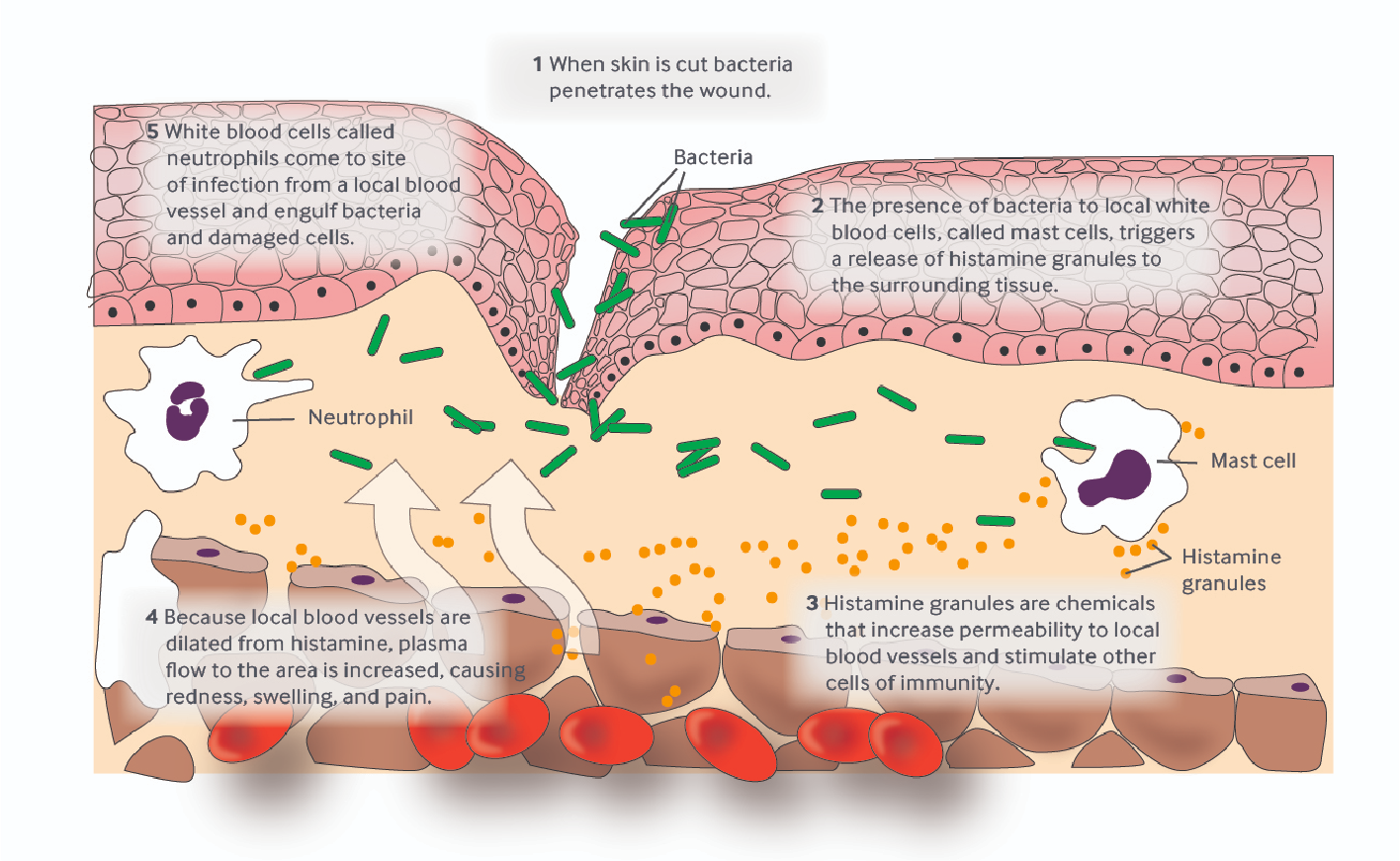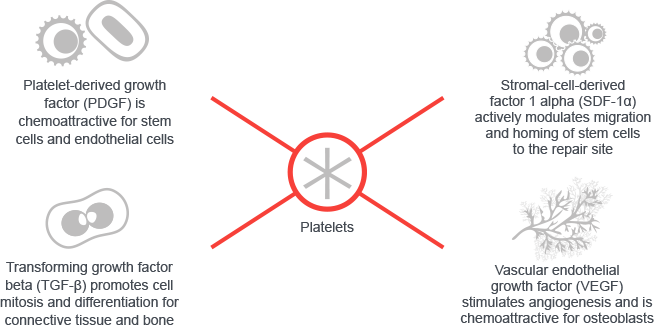Platelet-Rich Plasma (PRP)
PRP is an autologous biologic derived from whole blood that is preferentially enriched for platelets.
While platelets are the primary component of PRP, preparations may also contain other cellular components such as white blood cells (WBCs) and peripheral stem cells. These components all play a biological role in the healing process and are provided at concentrated levels in PRP. Thus, PRP may help optimize the conditions for healing of bone and soft tissue.
For medical inquiries, please contact medical affairs.
Learn more about the healing power of platelet-rich plasma in our latest infographic.
- Components of PRP
- Mechanisms of action
- Potential for infection control
Platelets
White Blood Cells
Progenitor Cells
 Platelets play a critical role in several aspects of the healing process. Activated platelets express adhesion molecules that support clot formation for hemostasis. They also release several antimicrobial peptides that deliver properties for infection control. Most importantly as it relates to healing, platelets also release chemokines and numerous growth factors, including SDF-1α, PDGF, TGF-β and VEGF, that have been shown to orchestrate key biological processes, including angiogenesis, inflammation resolution and tissue regeneration.1,2,3,4
Platelets play a critical role in several aspects of the healing process. Activated platelets express adhesion molecules that support clot formation for hemostasis. They also release several antimicrobial peptides that deliver properties for infection control. Most importantly as it relates to healing, platelets also release chemokines and numerous growth factors, including SDF-1α, PDGF, TGF-β and VEGF, that have been shown to orchestrate key biological processes, including angiogenesis, inflammation resolution and tissue regeneration.1,2,3,4
White Blood Cells (WBCs)
WBCs (leukocytes) play a key role in protecting the body from infection and coordinating the inflammatory response. The three primary classes of cells found in the WBC population each provide unique biological functionalities:
GRANULOCYTES (NEUTROPHILS)
- The “immediate response” cells for prevention of infection
- Key mediators of inflammatory response through phagocytosis and release of reactive oxygen species (ROS)
LYMPHOCYTES
- T-lymphocytes help regulate the function of other immune cells and directly attack various infected cells and tumors
- B-lymphocytes make antibodies, which are proteins that target unwanted bacteria, viruses and other foreign material
MONOCYTES
- Assist in pathogen recognition
- Eventually become macrophages, which engulf and destroy pathogens
Nonspecific Inflammatory Response
WBCs travel through the body to address inflammatory conditions.

 Progenitor Cells
Progenitor cells convert to terminal tissue and support angiogenesis. Endothelial progenitor cells also retain the ability to differentiate into other cell types, but to a lesser extent than stem cells.5,6
Progenitor Cells
Progenitor cells convert to terminal tissue and support angiogenesis. Endothelial progenitor cells also retain the ability to differentiate into other cell types, but to a lesser extent than stem cells.5,6
Help Optimize the Conditions Needed for Healing With PRP
The concept behind the clinical use of PRP is to harness the natural biological components of a patient’s blood―primarily platelets―which may help optimize the conditions for healing, improve inflammatory response, control infection and promote angiogenesis.7,8,9
Platelets facilitate healing through release of many growth factors actively involved in this process. Thus, PRP offers the physician an alternative to other widespread options, such as steroid injections that provide short-term relief by masking symptoms such as pain and inflammation that are the result of an injury, rather than actually addressing the cause of the injury directly through repair of damaged tissue.10,11,12
Learn more about the power of platelet-rich plasma.
High Concentrations of Key Growth Factors
Platelet concentration is directly proportional to growth factor concentration.13
When more platelets are concentrated in a PRP preparation, more growth factors are delivered to the application site. These growth factors support several key processes, including stem cell recruitment, angiogenesis, cell proliferation and differentiation.14
PRP provides high concentrations of several key growth factors involved in healing and tissue regeneration, including:

1Tang Y, Yeaman M, Selsted M. Antimicrobial peptides from human platelets. Infect Immun. 2002;70(12):6524-6533.
2Drago L, Bortolin M, Vassena C, et al. Antimicrobial activity of pure platelet-rich plasma against microorganisms isolated from oral cavity. BMC Microbiol. 2013:13(47):1-5.
3Amable P, Carias R, Teixeira M, et al. Platelet-rich plasma preparation for regenerative medicine: optimization and quantification of cytokines and growth factors. Stem Cell Res Ther. 2013;4(3):67.
4Ríos D, López C, Carmona J. Platelet-rich gel supernatants stimulate the release of anti-inflammatory proteins on culture media of normal equine synovial membrane explants. Vet Med Int. 2015;2015:547052.
5Jung Y, Song J, Shiozawa Y, et al. Hematopoietic stem cells regulate mesenchymal stromal cell induction into osteoblasts thereby participating in the formation of the stem cell niche. Stem Cells. 2008;26(8):2042-2051.
6Kuroda R, Matsumoto T, Kawakami Y, Fukui T, Mifune Y, Kurosaka M. Clinical impact of circulating CD34-positive cells on bone regeneration and healing. Tissue Engineering Part B: Reviews. 2014;20(3):190-199.
7Giusti I, Rughetti A, D’Ascenzo S, et al. Identification of an optimal concentration of platelet gel for promoting angiogenesis in human endothelial cells. Transfusion. 2009;49(4):771-778.
8El-Sharkawy H, Kantarci A, Deady J, et al. Platelet-rich plasma: growth factors and pro- and anti-inflammatory properties. J Periodontol. 2007;78(4):661-669.
9Fiore S, Serhan C. Lipoxin A4 receptor activation is distinct from that of the formyl peptide receptor in myeloid cells: inhibition of CD11/18 expression by lipoxin A4-lipoxin A4 receptor interaction. Biochemistry. 1995;34(51):16678-16686.
10Dai W, Zhou A, Zhang H, Zhang J. Efficacy of platelet-rich plasma in the treatment of knee osteoarthritis: a meta-analysis of randomized controlled trials. Arthroscopy. 2017;33(3):659-670.e1.
11Cai Y, Zhang C, Lin X. Efficacy of platelet-rich plasma in arthroscopic repair of full-thickness rotator cuff tears: a meta-analysis. J Shoulder Elbow Surg. 2015;24(12):1852-1859.
12Fitzpatrick J, Bulsara M, Zheng M. The effectiveness of platelet-rich plasma in the treatment of tendinopathy: a meta-analysis of randomized controlled clinical trials. Am J Sports Med. 2016;45(1):226-233.
13Eppley BL, Woodell JE, Higgins J. Platelet quantification and growth factor analysis from platelet-rich plasma: implications for wound healing. Plast Reconstr Surg. 2004;114(6):1502-1508.
14Kevy S, et al. Defining the composition and healing effect of platelet-rich plasma for regenerative medicine. Presented at: 2010 TERMIS Americas; 5 to 8 December 2010; Orlando, Florida.
Risk Information: These procedures require needle access, possibly resulting in discomfort, tenderness, bruising, swelling, bleeding or pain at the access site, at which there is a small risk of infection. Lightheadedness, fainting, nausea or vomiting may occur. Before any medical procedure, review prescription and nonprescription medications and any natural or herbal remedies your patient is taking or plans to take.